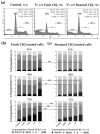Anti-Leukemic Effects on a U937 Cell Line of Fresh and Steamed Chinese Kale Juice and Their Pro-Apoptotic Effects via a Caspase-Dependent Pathway
- PMID: 37048295
- PMCID: PMC10094306
- DOI: 10.3390/foods12071471
Anti-Leukemic Effects on a U937 Cell Line of Fresh and Steamed Chinese Kale Juice and Their Pro-Apoptotic Effects via a Caspase-Dependent Pathway
Abstract
Chinese kale is a vegetable belonging to the family Brassicaceae in which members of this family produce unique metabolites called glucosinolates and isothiocyanates. These substances have been found to exhibit many benefits to human health. This study aimed to investigate and compare the contents of glucosinolates and isothiocyanates, and the anti-leukemic activity of fresh and steamed Chinese kale juice (CKJ). Cell viability and proliferation activity of U937 cells treated with CKJ were determined. Cell apoptosis and alterations of apoptosis-related protein expression were studied. Results showed that CKJ significantly decreased the viability of leukemic cells and inhibited cell proliferation in a dose- and time-dependent manner. After treatment with 5% v/v fresh and steamed CKJ for 24 h, the percentage of apoptotic cells increased to 53% and 36%, respectively. Increased amounts of cleaved caspase-3 in U937 cells treated with CKJ were observed, indicating that CKJ can trigger apoptotic cell death through a caspase-dependent pathway. Fresh CKJ was found to be more effective than steamed CKJ in suppressing cell survival and inducing cell apoptosis. The results suggest that Chinese kale possesses an anti-leukemic potential and could be further developed for cancer therapy and prevention. However, thermal cooking could reduce its beneficial function.
Keywords: Brassica; apoptosis; cancer; glucosinolate; isothiocyanate; kale; leukemia.
Conflict of interest statement
The authors declare no conflict of interest.
Figures




Similar articles
-
Disposition of glucosinolates and sulforaphane in humans after ingestion of steamed and fresh broccoli.Nutr Cancer. 2000;38(2):168-78. doi: 10.1207/S15327914NC382_5. Nutr Cancer. 2000. PMID: 11525594 Clinical Trial.
-
Cooking Methods for Preserving Isothiocyanates and Reducing Goitrin in Brassica Vegetables.Foods. 2023 Oct 2;12(19):3647. doi: 10.3390/foods12193647. Foods. 2023. PMID: 37835300 Free PMC article.
-
The flavor of Chinese kale sprouts is affected by genotypic variation of glucosinolates and their breakdown products.Food Chem. 2021 Oct 15;359:129824. doi: 10.1016/j.foodchem.2021.129824. Epub 2021 Apr 20. Food Chem. 2021. PMID: 33965761
-
Concentrations of thiocyanate and goitrin in human plasma, their precursor concentrations in brassica vegetables, and associated potential risk for hypothyroidism.Nutr Rev. 2016 Apr;74(4):248-58. doi: 10.1093/nutrit/nuv110. Epub 2016 Mar 5. Nutr Rev. 2016. PMID: 26946249 Free PMC article. Review.
-
Glucosinolate metabolism, functionality and breeding for the improvement of Brassicaceae vegetables.Breed Sci. 2014 May;64(1):48-59. doi: 10.1270/jsbbs.64.48. Breed Sci. 2014. PMID: 24987290 Free PMC article. Review.
References
-
- Wei Y.-F., Hao Y.-Y., Gao S., Li X.-Q., Liu F.-H., Wen Z.-Y., Wang H.-Y., Zhang S., Yan S., Luan M., et al. Pre-diagnosis cruciferous vegetables and isothiocyanates intake and ovarian cancer survival: A prospective cohort study. Front. Nutr. 2021;8:778031. doi: 10.3389/fnut.2021.778031. - DOI - PMC - PubMed
Grants and funding
LinkOut - more resources
Full Text Sources
Research Materials

